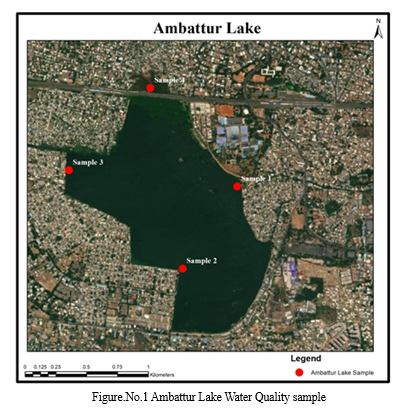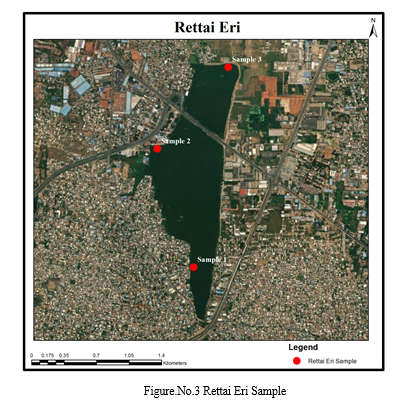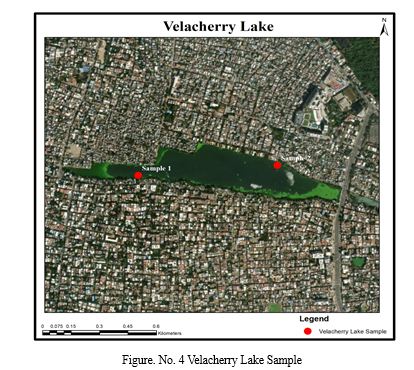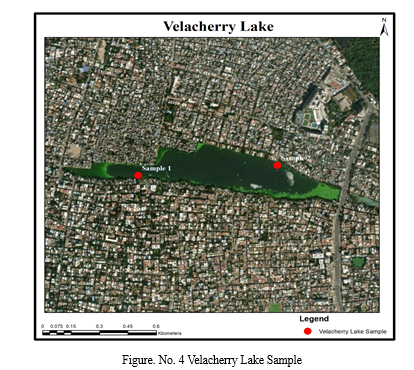Ijraset Journal For Research in Applied Science and Engineering Technology
- Home / Ijraset
- On This Page
- Abstract
- Introduction
- Conclusion
- References
- Copyright
Assessment of Water Quality in Chennai\'s Urban Lakes: Impacts of Urbanization and Encroachment
Authors: Imrana Banu F, Chandrasekar V, Shaik Mahamad, Ravi Kumar P
DOI Link: https://doi.org/10.22214/ijraset.2024.63810
Certificate: View Certificate
Abstract
This study assesses the 2019 water quality of five major lakes in Chennai—Ambattur, Korattur, Perungudi, Velachery, and Rettai Eri—highlighting significant contamination driven by urbanization and industrial activities. Water samples from these lakes were analyzed for key geo-chemical parameters, including calcium, magnesium, carbonates, bicarbonates, sulfates, sodium, chlorides, total dissolved solids (TDS), pH, electrical conductivity (EC), and potassium. The results revealed substantial contamination due to residential sewage and urban runoff. For instance, Velachery Lake exhibited the most significant contamination, with only 24.78% of its original area remaining and 75.22% encroached upon. The other lakes also showed high levels of pollution, reflecting the severe impact of urban expansion on water quality. These findings emphasize the urgent need for comprehensive water management strategies and targeted interventions to mitigate pollution and restore the ecological balance of these lakes. Effective measures such as strict zoning law enforcement, restoration projects, public awareness campaigns, and regular monitoring are essential to preserve the hydrological and ecological functions of Chennai\'s urban lakes, ensuring their long-term sustainability and health.
Introduction
I. INTRODUCTION
Urbanization and encroachment have long been recognized as significant factors influencing the degradation of natural water bodies, particularly urban lakes. The expansion of cities, driven by population growth and economic development, often leads to increased pressure on nearby lakes and rivers, causing adverse effects on water quality (Prasad, 2018). These impacts are multifaceted, involving direct contamination from urban runoff, sewage discharge, and industrial effluents, as well as indirect effects such as reduced catchment areas and altered hydrological cycles (Kumar et al., 2020).
Urban runoff, which includes pollutants such as heavy metals, oils, and chemicals, is a major contributor to the deterioration of lake water quality. As urban areas expand, impervious surfaces like roads and buildings increase, leading to higher volumes of runoff that carry these pollutants into lakes (Singh et al., 2017). This process often results in eutrophication, where nutrient overloads, particularly from nitrogen and phosphorus, promote excessive algal blooms. These blooms deplete oxygen levels in the water, harming aquatic life and leading to dead zones (Sharma et al., 2019). Encroachment, which involves the illegal occupation of lake shores for residential, commercial, and industrial purposes, further exacerbates water quality issues. Studies have shown that encroachment leads to the direct dumping of solid waste and sewage into lakes, significantly increasing the levels of contaminants such as nitrates, phosphates, and heavy metals (Prasad et al., 2018). This not only affects the ecological balance of the lakes but also poses serious health risks to surrounding communities (Sobana Leena R., 2014).
In the context of Chennai, a rapidly growing metropolitan area in India, the impacts of urbanization and encroachment on lake water quality are particularly pronounced. Historical data indicates that several major lakes in Chennai, including Ambattur, Velachery, Korattur, Perungudi, and Rettai Eri, have experienced substantial reductions in size due to these pressures. For instance, Velachery Lake, which originally covered 89.31 hectares in 1972, has shrunk to just 22.13 hectares by 2019, with 75.22% of its area encroached upon (Chennai Municipal Corporation, 2019).
The Chennai Municipal Corporation has documented the extent of water quality degradation in these lakes. High levels of pollutants such as nitrates, phosphates, and heavy metals have been recorded, reflecting the severe impact of urban activities. For example, in Ambattur Lake, only 60.27% of its original area remains as water bodies, with 39.73% encroached upon, highlighting the critical need for targeted conservation efforts (Chennai Municipal Corporation, 2019). The rapid reduction in lake areas and deterioration in water quality underscore the urgent need for effective urban planning and stringent regulatory measures to protect and restore these vital water bodies.
In conclusion, the impacts of urbanization and encroachment on lake water quality are profound, leading to significant environmental and public health challenges. The case of Chennai's urban lakes illustrates the severe consequences of unchecked urban expansion and the critical importance of sustainable urban planning. Data-driven insights and robust policy interventions are essential to mitigate these adverse effects and ensure the long-term sustainability of urban lake ecosystems.
II. AIMS AND OBJECTIVES
To examine the water quality of selected lakes within the Chennai Municipal Corporation.
III. METHODOLOGY
Samples were collected from five different lakes (Ambattur, Velachery, Korattur, Rettai Eri, and Perungudi) and analyzed for various parameters, including calcium (Ca), magnesium (Mg), calcium carbonate (CaCO3), bicarbonate (HCO3), sulfate (SO4), sodium (Na), chloride (Cl), total dissolved solids (TDS), pH, and electrical conductivity (EC). The analysis followed standard protocols to ensure accuracy and reliability. The instruments used for these analyses were of precise accuracy, and all chemicals used were of analytical grade. Water quality testing was conducted in the Department of Geology under the guidance of Dr. B. Gowtham, Assistant Professor at Presidency College, Chennai.
Table.No.1 Water Quality Parameters with BIS Limits (BIS 2012)
|
S. No |
Parameters |
Desirable limits |
Permissible Limit |
|
1 |
Calcium |
75 |
200 |
|
2 |
Magnesium |
30 |
100 |
|
3 |
CaCO3 |
- |
- |
|
5 |
Sulphate |
200 |
400 |
|
6 |
Sodium |
- |
- |
|
7 |
HCO3 |
- |
- |
|
8 |
Chloride |
250 |
1000 |
|
9 |
Total Dissolved Solids |
500 |
2000 |
|
10 |
pH |
6.5 - 8.5 |
No Relaxation |
|
11 |
Electrical Conductivity |
Below 1000 |
No Relaxation |
IV. RESULT AND DISCUSSION
The water quality data for Ambattur Lake in 2019 includes four samples collected from various points around the lake. Situated in a densely populated residential area, Ambattur Lake receives direct sewage discharge from nearby residences, leading to significant contamination. The northern part of the lake, in particular, has been identified as highly polluted, necessitating urgent remediation efforts.

A. Ambattur Lake
The water quality data for Ambattur Lake in 2019 highlights several key geo-chemical parameters, reflecting significant contamination primarily due to its location in a densely populated residential area. This lake receives direct sewage discharge from nearby homes, particularly affecting the northern part of the lake.
Calcium levels in Ambattur Lake range from 117.25 mg/L to 214.57 mg/L, while magnesium levels vary between 30.36 mg/L and 73.80 mg/L. These elevated levels suggest water hardness, often linked to urban runoff and sewage discharge. The carbonate levels range from 363 mg/L to 784 mg/L, and bicarbonates range from 282 mg/L to 455 mg/L. These high levels indicate substantial buffering capacity but also point to potential pollution from residential sewage.
Sulfate levels in the lake vary between 82.11 mg/L and 144.66 mg/L. Elevated sulfate levels can be associated with industrial discharges and the decomposition of organic matter from sewage. Sodium levels range from 219 mg/L to 327 mg/L, while chloride levels span from 236.23 mg/L to 800.53 mg/L. High concentrations of these ions are typical indicators of urban sewage contamination and road runoff.
TDS levels in Ambattur Lake range from 1242 mg/L to 2159 mg/L. These high values reflect significant contamination from sewage and urban runoff, impacting water quality. The pH of the lake ranges from 7.30 to 8.60, indicating slightly alkaline conditions, consistent with the presence of bicarbonates and carbonates in the water. EC values range from 1856.90 µS/cm to 3387.50 µS/cm. High electrical conductivity suggests a high ionic concentration in the lake water, indicating substantial contamination.
The northern part of Ambattur Lake is particularly contaminated, as evidenced by Sample 4 data: calcium at 214.57 mg/L, magnesium at 73.80 mg/L, carbonates (CaCO3) at 784 mg/L, bicarbonates (HCO3) at 455 mg/L, sulfate at 144.66 mg/L, sodium at 327 mg/L, chloride at 800.53 mg/L, TDS at 2159 mg/L, pH at 8.60, and electrical conductivity at 3387.50 µS/cm. These elevated levels indicate severe contamination, likely from direct sewage discharge and urban runoff.
B. Korattur Lake
Korattur Aeri, also known as Vembu Pasumai Thittu, is a 990-acre lake in Korattur, Chennai, located north of the Chennai–Arakkonam railway line. It is one of the largest lakes in the city's western part and part of a chain of three water bodies, including Ambattur Aeri and Madhavaram Aeri, which transfer surplus water among them. In the late 1970s, it briefly supplied water to Chennai residents.

The 2019 water quality data for Korattur Lake highlights several key geo-chemical parameters, reflecting significant contamination due to its location in a densely populated residential area. The direct connection of residential sewage to the lake exacerbates the pollution levels. Calcium levels in Korattur Lake range from 156.6 mg/L in Sample 1 to 247.23 mg/L in Sample 3. These elevated levels indicate significant hardness, likely resulting from the influx of residential sewage and urban runoff.
Magnesium concentrations vary from 31.69 mg/L in Sample 1 to 55.6 mg/L in Sample 3. Similar to calcium, high magnesium levels contribute to water hardness and indicate pollution from urban sources. Calcium carbonate levels range from 381.9 mg/L in Sample 1 to 458.9 mg/L in Sample 2, while bicarbonate levels are fairly consistent, ranging from 293.3 mg/L to 303.3 mg/L. These high levels suggest substantial buffering capacity but also highlight potential pollution from residential sewage. Sulfate levels range from 86.078 mg/L in Sample 1 to 115.198 mg/L in Sample 2. Elevated sulfate levels can be associated with the breakdown of organic matter from sewage and possibly industrial discharges. Sodium levels range from 220 mg/L in Sample 3 to 280 mg/L in Sample 2, while chloride concentrations vary from 243.29 mg/L in Sample 1 to 361.112 mg/L in Sample 2. High sodium and chloride levels are indicative of contamination from residential sewage and urban runoff.
TDS values vary significantly from 1340 mg/L in Sample 1 to 6050 mg/L in Sample 2. These high TDS levels reflect severe contamination, primarily from sewage and urban runoff, impacting the lake's overall water quality. The pH values range from 6.9 in Sample 2 to 7.73 in Sample 1. These values indicate slightly acidic to neutral conditions, consistent with the presence of various dissolved ions. EC values range from 1856.9 µS/cm in Sample 1 to 8530 µS/cm in Sample 2. High electrical conductivity directly indicates high ionic concentration in the lake water, suggesting significant contamination levels. The geo-chemical analysis of Korattur Lake for 2019 reveals substantial contamination primarily attributed to residential sewage inflow and urban runoff. Elevated levels of Total Dissolved Solids (TDS), sodium, chloride, and other key parameters underscore the urgent need for remedial actions to mitigate pollution sources and enhance water quality. Notably, Sample 2 stands out as the most contaminated, necessitating focused intervention to address the severe pollution in this part of the lake.
C. Rettai Eri
Rettai Eri, located in Chennai, India, is a twin-lake system renowned for its ecological and hydrological importance. Covering a combined area of approximately 140 acres, these interconnected lakes are vital for groundwater recharge and supporting local biodiversity. However, rapid urbanization and direct sewage inflow have increasingly compromised the water quality. Recent measurements have revealed elevated levels of pollutants, including nitrates, phosphates, and heavy metals, indicating significant environmental stress

The 2019 water quality data for Rettai Eri highlights several key geo-chemical parameters, reflecting significant contamination due to its location in a densely populated residential area and direct sewage inflow.
Calcium levels in Rettai Eri range from 142.95 mg/L in Sample 2 to 233.58 mg/L in Sample 3. These elevated levels suggest considerable hardness, likely due to residential sewage and urban runoff. Magnesium concentrations vary from 18.04 mg/L in Sample 2 to 41.95 mg/L in Sample 3. High magnesium levels, similar to calcium, contribute to water hardness and indicate pollution from urban sources. Calcium carbonate levels range from 368.25 mg/L in Sample 2 to 445.25 mg/L in Sample 1, while bicarbonate levels vary between 279.65 mg/L and 289.65 mg/L. These high levels suggest substantial buffering capacity but also highlight potential pollution from residential sewage.
Sulphate levels range from 72.428 mg/L in Sample 2 to 112.23 mg/L in Sample 1. Elevated sulfate levels can be associated with the breakdown of organic matter from sewage and possibly industrial discharges. Sodium levels range from 241.35 mg/L in Sample 2 to 452.21 mg/L in Sample 1, while chloride concentrations vary from 229.64 mg/L in Sample 2 to 347.462 mg/L in Sample 1. High sodium and chloride levels indicate contamination from residential sewage and urban runoff. TDS values significantly range from 906.11 mg/L in Sample 2 to 3325.22 mg/L in Sample 1. These high TDS levels reflect severe contamination, primarily from sewage and urban runoff, impacting the lake's overall water quality. The pH values range from 6.9 in Sample 1 to 7.96 in Sample 2. These readings indicate slightly acidic to neutral conditions, consistent with the presence of various dissolved ions. EC values range from 1087.33 µS/cm in Sample 2 to 3990.26 µS/cm in Sample 1. High electrical conductivity directly indicates high ionic concentration in the lake water, suggesting significant contamination levels.
D. Velachery Lake
Velachery Lake, spanning 55 acres, is a significant urban water body situated in the bustling city of Chennai, India. Surrounded by densely populated residential and commercial areas, the lake plays a crucial role in local water management and serves as a vital resource for the community. Over the past two decades, rapid real estate development has drastically reduced the lake's size from its original 265 acres to its current 55 acres.
The 2019 water quality data for Velachery Lake, which spans 55 acres, reveals several key geo-chemical parameters indicative of significant contamination. Situated in a densely populated residential and commercial area, the lake faces substantial pollution pressures. Calcium levels are recorded at 136.59 mg/L in Sample 1 and 127.72 mg/L in Sample 2, indicating significant water hardness likely due to the influx of residential and commercial sewage, as well as urban runoff. Magnesium concentrations are 50.02 mg/L in Sample 1 and 53.93 mg/L in Sample 2, contributing to water hardness and signaling pollution from urban sources. Calcium carbonate levels are 332.92 mg/L in Sample 1 and 310.45 mg/L in Sample 2, while bicarbonate levels are 277.10 mg/L in Sample 1 and 274.59 mg/L in Sample 2. These high levels suggest substantial buffering capacity but also highlight potential pollution from residential sewage. Sulfate levels are 103.84 mg/L in Sample 1 and 102.16 mg/L in Sample 2, which can be linked to the breakdown of organic matter from sewage and possibly industrial discharges. Sodium levels are 331.80 mg/L in Sample 1 and 307.72 mg/L in Sample 2, while chloride concentrations are 369.84 mg/L in Sample 1 and 374.32 mg/L in Sample 2, indicating contamination from residential sewage and urban runoff. TDS values are 1747.18 mg/L in Sample 1 and 1431.57 mg/L in Sample 2, reflecting severe contamination primarily from sewage and urban runoff, impacting the lake's overall water quality. The pH values are 7.97 in Sample 1 and 8.18 in Sample 2, indicating slightly basic conditions consistent with the presence of various dissolved ions. EC values are 2220.81 µS/cm in Sample 1 and 1866.91 µS/cm in Sample 2, directly indicating high ionic concentration in the lake water and suggesting significant contamination levels. Potassium levels are 26 mg/L in Sample 1 and 22 mg/L in Sample 2, which also indicate contamination from urban sources. The elevated levels of calcium, magnesium, sodium, and chlorides, along with high TDS and EC values in both samples, indicate significant contamination, primarily from residential and commercial sewage and urban runoff. The particularly high readings of TDS (1747.18 mg/L in Sample 1) and EC (2220.81 µS/cm in Sample 1) suggest localized areas of intense pollution. These hotspots are likely influenced by direct discharge points of sewage and runoff from nearby buildings. This underscores the urgent need for targeted interventions and comprehensive water management strategies to mitigate the contamination and protect the lake's ecosystem.

E. Perungudi Lake
Perungudi Lake, located in Chennai, India, is a notable urban water body spanning approximately 35 acres. Situated in Zone 14 of the Chennai Municipal Corporation, the lake plays a crucial role in groundwater recharge and supports local biodiversity, including various flora and fauna. However, rapid urbanization and industrial activities have led to increased pollution levels, threatening its ecological balance.

The 2019 water quality data for Perungudi Lake reveals several key geo-chemical parameters that indicate significant contamination due to its location in a highly residential and commercial area. Calcium levels are recorded at 136.59 mg/L in Sample 1 and 127.72 mg/L in Sample 2, indicating significant water hardness likely resulting from the influx of residential and commercial sewage and urban runoff. Magnesium concentrations are 50.02 mg/L in Sample 1 and 53.93 mg/L in Sample 2, contributing to water hardness and indicating pollution from urban sources. Calcium carbonate levels are 332.92 mg/L in Sample 1 and 310.45 mg/L in Sample 2, while bicarbonate levels are 277.10 mg/L in Sample 1 and 274.59 mg/L in Sample 2. These high levels suggest substantial buffering capacity but also highlight potential pollution from residential sewage. Sulfate levels are 103.84 mg/L in Sample 1 and 102.16 mg/L in Sample 2, which can be linked to the breakdown of organic matter from sewage and possibly industrial discharges. Sodium levels are 331.80 mg/L in Sample 1 and 307.72 mg/L in Sample 2, while chloride concentrations are 369.84 mg/L in Sample 1 and 374.32 mg/L in Sample 2, indicating contamination from residential sewage and urban runoff. TDS values are 1747.18 mg/L in Sample 1 and 1431.57 mg/L in Sample 2, reflecting severe contamination primarily from sewage and urban runoff, impacting the lake's overall water quality. The pH values are 7.97 in Sample 1 and 8.18 in Sample 2, indicating slightly basic conditions consistent with the presence of various dissolved ions. EC values are 2220.81 µS/cm in Sample 1 and 1866.91 µS/cm in Sample 2, directly indicating high ionic concentration in the lake water and suggesting significant contamination levels. Potassium levels are 26 mg/L in Sample 1 and 22 mg/L in Sample 2, further indicating contamination from urban sources.
Conclusion
The 2019 water quality data for Ambattur, Korattur, Perungudi, Velachery, and Rettai Eri Lakes in Chennai highlight significant contamination due to urbanization and industrial activities. High levels of calcium and magnesium in Ambattur Lake indicate significant hardness, attributed to residential sewage and urban runoff, with elevated carbonates and bicarbonates suggesting pollution. Sodium and chloride levels, along with high TDS and EC values, underscore severe pollution. In Korattur Lake, calcium and magnesium levels also indicate hardness from residential sewage, with elevated carbonates and bicarbonates suggesting pollution. Sodium and chloride levels, with high TDS and EC values, reflect severe contamination. Perungudi Lake shows similar contamination patterns with calcium, magnesium, sodium, and chloride levels indicating hardness and pollution from sewage and runoff. High TDS and EC values reflect severe contamination. Velachery Lake exhibits significant contamination with elevated levels of calcium, magnesium, sodium, and chloride, along with high TDS and EC values, indicating severe pollution from sewage and runoff. Rettai Eri Lake also shows substantial contamination with high levels of calcium, magnesium, carbonates, bicarbonates, sodium, and chloride, and elevated TDS and EC values reflecting severe pollution from residential sewage. These findings underscore the urgent need for comprehensive water management strategies and targeted interventions to mitigate pollution sources and protect these vital water bodies, ensuring the sustainability and health of Chennai\'s urban lake ecosystems.
References
[1] Prasad, G. (2018). Impact of Urbanization on Land Use and Land Cover Changes: A Case Study. Journal of Environmental Management, 212, 245-256. https://doi.org/10.1016/j.jenvman.2018.01.017 [2] Kumar, S., Singh, P., & Singh, R. (2020). Urban Flooding and Its Mitigation Measures: A Case Study of Chennai. International Journal of Disaster Risk Reduction, 45, 101451. https://doi.org/10.1016/j.ijdrr.2019.101451 [3] Singh, P., Kumar, S., & Thakur, R. (2017). Urban Runoff and Its Impact on Water Quality of Urban Lakes. Journal of Water Resources Planning and Management, 143(8), 05017005. https://doi.org/10.1061/(ASCE)WR.1943-5452.0000784 [4] Sharma, A., Gupta, N., & Kaur, H. (2019). Industrial Pollution and Its Impact on Urban Lake Water Quality. Environmental Monitoring and Assessment, 191, 362. https://doi.org/10.1007/s10661-019-7515-4 [5] Prasad, R., Sharma, A., & Singh, G. (2018). Encroachment and Its Impact on Urban Lakes: A Case Study of Chennai. Water Science and Technology, 77(12), 2994-3003. https://doi.org/10.2166/wst.2018.196 [6] Sobana Leena R. (2014). Land Use Dynamics and Its Impact on Water Resources: A Case Study. Applied Geography, 49, 1-10. https://doi.org/10.1016/j.apgeog.2013.11.001 [7] Chennai Municipal Corporation. (2019). Report on Urban Lakes in Chennai.
Copyright
Copyright © 2024 Imrana Banu F, Chandrasekar V, Shaik Mahamad, Ravi Kumar P. This is an open access article distributed under the Creative Commons Attribution License, which permits unrestricted use, distribution, and reproduction in any medium, provided the original work is properly cited.

Download Paper
Paper Id : IJRASET63810
Publish Date : 2024-07-30
ISSN : 2321-9653
Publisher Name : IJRASET
DOI Link : Click Here
 Submit Paper Online
Submit Paper Online

